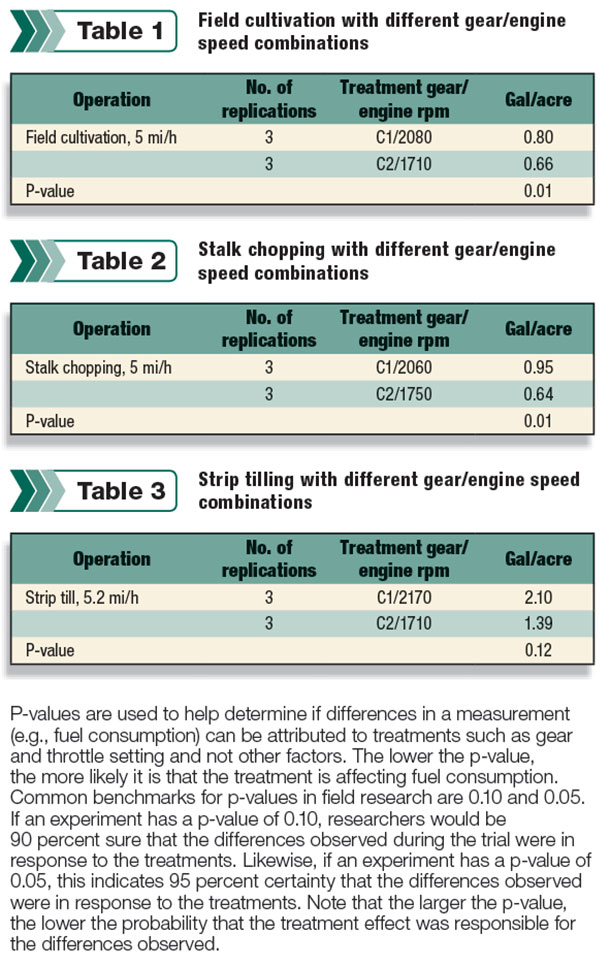The results of using this technique were recently demonstrated in a series of field trials at the Iowa State University (ISU) Northeast Research and Demonstration Farm near Nashua, Iowa. The Iowa Energy Center, ISU Extension and Outreach, and the ISU research and demonstration farms collaborated on this case study.
Research farm staff mounted an auxiliary 12-gallon fuel tank on a John Deere 7430 tractor. Plumbing was added for diesel fuel to be supplied and returned from the engine either through the main fuel tank or the auxiliary fuel tank, depending on the setting of a single flow control valve. A load cell under the auxiliary fuel tank measured the net weight of fuel consumed (fuel supplied to the engine minus fuel returned from the engine).
Fuel consumption was measured as gallons per acre (gal/acre). Although larger tractors and larger implements typically consume fuel at higher rates, larger equipment also can cover the same number of acres in fewer hours.
Regardless of a tractor’s size, the gallons per acre measurement provides a fair and consistent comparison across different tractor models as well as a common, useful benchmark for farmers.
Most of the fieldwork at the research farm is conducted on small plot areas. One goal was to measure fuel consumption in areas of 0.7 to 1.0 acre when possible to enhance measurement precision. Another goal was to obtain multiple replications if enough land area was available.
Extremely small plot areas often conflicted with these goals. Therefore, the ability to determine statistical significance of the results was limited in some cases.
Research farm staff measured tractor fuel consumption during field operations such as field cultivation, stalk chopping, and strip tilling. The results shown in the tables below were collected in the first year of this case study (2013).
Future field trials may include tillage depth, tractor tire inflation and ballasting, fuel and air filter maintenance, and managing tractor gear and throttle settings with partial drawbar loads.
Shifting up and throttling back saves fuel
The effects of shifting up one transmission gear and throttling back the engine’s speed were measured during field cultivation in the spring (Table 1). In the fall, the same technique was used for stalk chopping (Table 2) and strip tillage (Table 3). In each case, the tractor pulled the implement through the field at the same travel speed and accomplished the same amount of fieldwork in a given time.
These operations required only a portion of the engine power available from the John Deere 7430 tractor. Therefore, shifting into a higher transmission gear and reducing the throttle setting allowed the tractor to maintain a consistent travel speed while simultaneously operating at a reduced engine speed (lower rpm).
In all cases, the combination of shifting to a higher gear and reducing the engine’s speed reduced fuel consumption. The fuel savings, comparing fuel used in the higher gear to that used with the engine operating nearer full throttle in the lower gear, was 21, 48 and 51 percent, respectively, for field cultivation, stalk chopping and strip tilling.
Despite a small number of replications, trends in the data were strong enough to be statistically significant (< 0.10) for field cultivation and stalk chopping.
Tractors used for row crop operations frequently use only a portion of total drawbar power that is available from the tractor’s engine. Tests at the University of Nebraska Tractor Test Lab frequently show fuel savings of 10 to 20 percent due to shifting up and throttling back at lighter drawbar loads.
Planting, light tillage or spraying (unless the pump is power take-off powered) may also offer opportunities to use this technique if the full power of the tractor isn’t required.
Note: reducing engine speed is not a good strategy when using the power take-off (PTO) for implements that require full PTO speed. In this case, satisfactory stalk chopping was done in existing field conditions by using reduced speed (Table 2). FG

—From Iowa State University, Extension and Outreach newsletter









